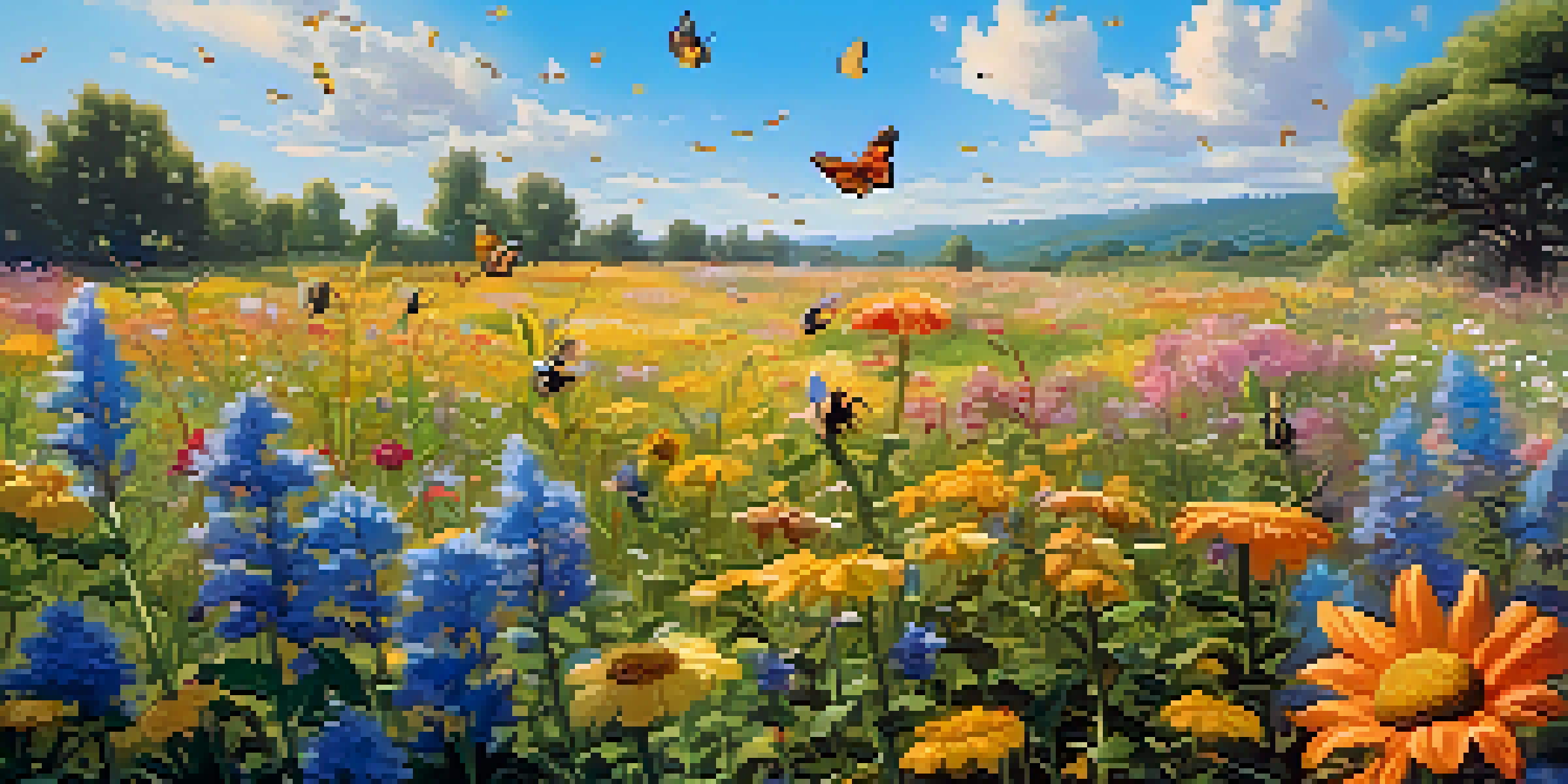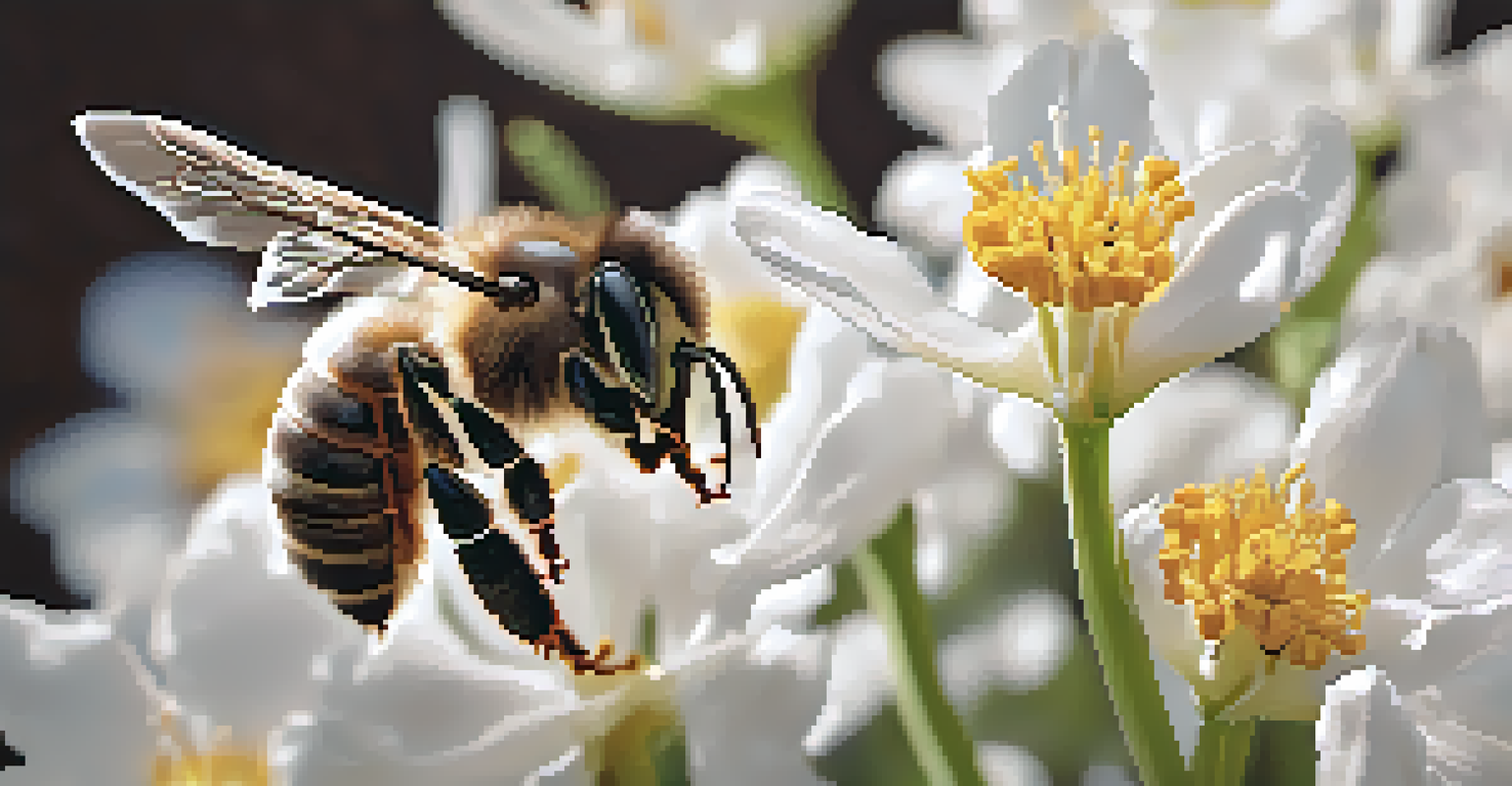How Pollinators Affect the Genetic Diversity of Plants

Understanding the Role of Pollinators in Ecosystems
Pollinators, such as bees, butterflies, and birds, play a crucial role in our ecosystems. They facilitate the process of pollination, which is essential for the reproduction of many flowering plants. Without these busy creatures, many plants would struggle to produce seeds and fruits, leading to a decline in biodiversity.
The hum of bees is the voice of the garden.
In essence, pollinators act as nature's matchmakers, transferring pollen from one flower to another. This process not only aids in plant reproduction but also helps maintain the balance of ecosystems. When pollinators thrive, they support a rich tapestry of life that includes various plant and animal species.
Moreover, the health of pollinator populations reflects the overall health of our environment. Healthy pollinator communities indicate a thriving ecosystem, while declines can signal underlying environmental issues. Thus, understanding their role is vital for ecological balance.
How Pollination Influences Plant Genetics
Pollination is more than just a means of reproduction; it is a driver of genetic diversity in plants. When pollen from different plants mixes, it leads to cross-pollination, which introduces new genetic material into the plant's gene pool. This genetic mixing is essential for creating resilient plant populations capable of adapting to changing environments.

Imagine a family tree where each branch represents a different trait; the more diverse the branches, the more adaptable the family becomes. Similarly, plants that experience diverse pollination have a better chance of surviving diseases, pests, and climate fluctuations. This genetic variation is crucial for long-term ecosystem health.
Pollinators Ensure Plant Diversity
Pollinators like bees and butterflies are essential for the reproduction of many flowering plants, supporting biodiversity in ecosystems.
In contrast, plants that rely solely on self-pollination can suffer from inbreeding, leading to a decrease in genetic diversity. This lack of variation can make them more vulnerable to threats, hindering their ability to flourish in a dynamic environment.
The Benefits of Genetic Diversity for Plants
Genetic diversity among plants enhances their ability to adapt to environmental changes. For instance, when a shift in climate occurs, plants with a wide range of genetic traits are more likely to survive and thrive. This adaptability ensures that ecosystems remain robust and can support various wildlife.
If we lose the bees, we lose a third of our food supply.
Think about it like a sports team; a diverse team with different skills can tackle various challenges more effectively. Similarly, genetically diverse plant populations can better withstand diseases, pests, and changing weather patterns. This resilience is crucial for maintaining food security and healthy ecosystems.
Additionally, diverse plant communities provide a variety of habitats for different species, promoting overall biodiversity. A rich genetic pool not only benefits the plants themselves but also supports the myriad life forms that depend on them.
Pollinators and the Survival of Endangered Plant Species
Some endangered plant species rely heavily on specific pollinators for their survival. When these pollinator populations decline, the plants that depend on them face increased risks of extinction. Protecting pollinators is, therefore, essential for preserving these unique plant species and the ecosystems they inhabit.
Take the example of the rare chocolate flower, which relies on a specific bee species for pollination. If that bee population dwindles, the chocolate flower's chances of survival decrease dramatically. This interdependence highlights the critical relationship between pollinators and plant conservation efforts.
Genetic Diversity Enhances Resilience
Cross-pollination among plants promotes genetic diversity, making them more adaptable to environmental changes and threats.
Conserving pollinator habitats and promoting biodiversity can help protect these endangered plant species. By ensuring that pollinators thrive, we can support the survival of plants that play vital roles in their ecosystems.
Impact of Human Activity on Pollinator Populations
Human activities, such as urbanization, pesticide use, and habitat destruction, have significantly impacted pollinator populations. These actions can lead to habitat loss and declining food sources, making it harder for pollinators to survive. Understanding this impact is crucial for creating effective conservation strategies.
For instance, the use of pesticides can harm not only target pests but also non-target species like bees and butterflies. This decline in pollinator numbers can have a cascading effect on plant diversity and health. Essentially, when we disrupt the pollinator network, we risk unraveling the fabric of our ecosystems.
By adopting more sustainable practices and creating pollinator-friendly habitats, we can help reverse these negative impacts. Actions like planting native flowers and reducing pesticide use can foster healthy pollinator populations and, in turn, promote plant genetic diversity.
Community Involvement in Pollinator Conservation
Community involvement plays a vital role in supporting pollinator conservation efforts. Local initiatives can help raise awareness and encourage people to create pollinator-friendly environments. Simple actions, like planting native flowers or creating bee hotels, can make a significant difference.
Consider a neighborhood garden project that focuses on planting diverse, native species. Not only does this provide food for pollinators, but it also beautifies the community and fosters a connection to nature. Engaging the community in these efforts can create a ripple effect, inspiring others to take action.
Human Impact Threatens Pollinators
Human activities, including habitat destruction and pesticide use, significantly harm pollinator populations, jeopardizing plant survival and ecosystem health.
Moreover, educational programs can help people understand the importance of pollinators and how they can contribute to their conservation. When communities come together to protect pollinators, they strengthen the bonds between people and the environment, ensuring a healthier ecosystem for all.
The Future of Pollinators and Plant Diversity
The future of our ecosystems hinges on the health of both pollinators and plants. As we face challenges like climate change and habitat loss, it's more important than ever to prioritize the conservation of these vital species. By fostering genetic diversity in plants through healthy pollinator populations, we can enhance ecosystem resilience.
Thinking ahead, it's crucial for policymakers, scientists, and communities to work together to protect pollinators and their habitats. Innovative approaches, such as creating wildlife corridors and promoting sustainable agriculture, can help safeguard these essential creatures. Every effort counts in ensuring the survival of both plants and pollinators.

Ultimately, a balanced ecosystem benefits everyone—plants, animals, and humans alike. By recognizing the interconnectedness of pollinators and plant diversity, we can create a brighter future for our natural world.